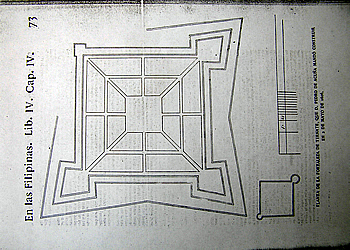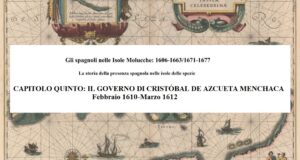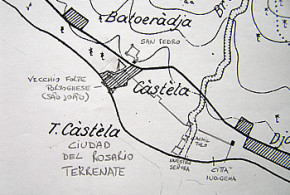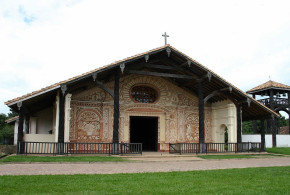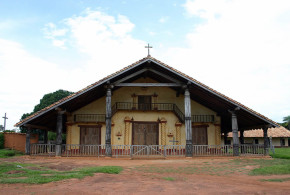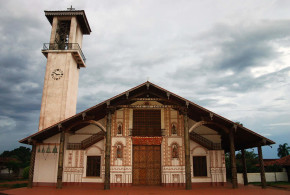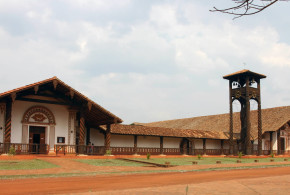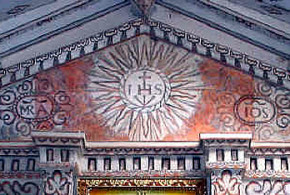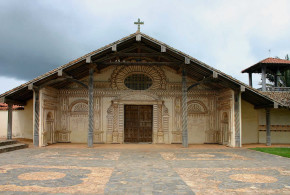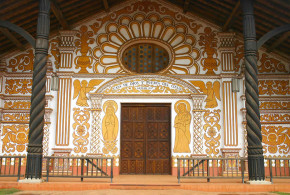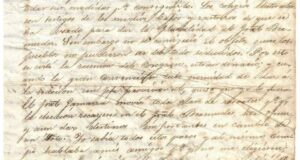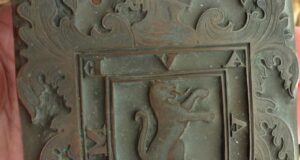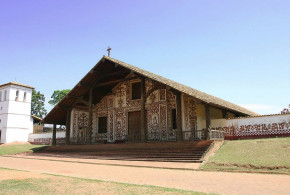Written by Marco Ramerini. English text revision by Dietrich Köster.
San Pedro, Sant Pedro, Fuerza Nueva: (1606/1610-1663) benteng Santo Pedro (Kastella)
Among the defenses of the Spanish city of Ternate: Ciudad del Rosario. There was also a fort set on a hill in the surroundings of the city. This fort was called San Pedro.
It seems that the Portuguese had already built a fortress on the hill behind the town of Ternate, already described in the “Livro das cidades e fortalezas que a coroa de Portugal tem nas partes da Índia …“. The Portuguese had built a bulwark, where some pieces of artillery had been placed between the mountains and the Portuguese fort on the island of Ternate, on an “outeiro alto, que por não lhe ficar por padrasto se occupou com hum baluarte que se nelle fez”. 1
Later after the Spanish occupation of Ternate had occurred in 1606, the Spaniards also spotted a hill, where a fort was to be built, in order to better defend the city
The fortress was situated behind the town of Gamolamo. According to van de Wall it was built by the Spaniards in 1606 soon after the conquest of Ternate. They called the new fort Fuerza Nueva. 2
Most likely the Fuerza Nueva of van de Wall is the fort referenced by Argensola, which is built (or rather whose construction, perhaps, is begun) by Esquivel, in 1606, in a “parte eminente, mayor y más fuerte”. 3
This new fort was built on a hill “un gran padrastro a la parte del volcán”, which dominated from above the old fort and the city of Ternate. Here the conformation of the ground and the dominant position was deemed perfect for the construction of the new fortress. According to the orders of Acuña the fort had to be square in shape, “que tenga de centro 600 pies”, and have three bastions. Esquivel gives us more information on the site chosen for the construction of this fort. It is located above the old fort “en el padrastro que tiene una parte donde una grande barranca hace espaldas y ciñe”. Here the Spaniards have found a suitable place where to build the new fort. 4 A plant of this fort has come down to us (see the map below). 5
Several Spanish manuscripts give us some more details of this fortress:
Many Spanish documents mention this fort with the name of San Pedro or a similar name. But it should not to be confused with the fort of San Pedro y San Pablo, located across the lagoon towards the Dutch fort of Malayo. The fort probably received this name in honor of the governor of the Philippines D. Pedro de Acuña, who conquered Ternate in 1606.
The distance between the old fort of Ternate and the new fort to be built on the hill overlooking the city is 340 feet (“pies”). 6 The engineer of the fort appears to have been Çapata. 7
In 1610 Azcueta speaks of it as the main defense of the city of Ternate. From the early days of his government he was engaged in improving and finishing the work of this fort “pase a fortificar el fuerte de St. P.o que es la principal fuerza por estar a cauallero desta”. 8
Even Gregorio de S. Esteban in his “Historia de las Malucas” informs us that Azcueta built the fortress of S. Pablo (error for San Pedro?), located near the town of Ternate on a hill (“padrastro“) that dominates it. 9 In the manuscript of the Informaciones of Pedro de la Fuente Urrez dated 1632 the fort is referred to as “… fuerte nombrado Sant Pedro retirada y eminencia de la Ciudad del Rosario y fuerza de Terrenate …”. 10 A document shows us that, at an unspecified date, Juan de Azebedo (Azevedo), was commander of this fort. 11
Under the government of Pedro Fernández del Rio (1642-1643) the fort of San Pedro, “retirada de la ciudad del Rosario de Therrenate puesto principal para su defensa”, was completely renovated. 12 And again in 1652 during the government of Francisco de Esteybar the fort of San Pedro was completely rebuilt “reedifico la fuerza San Pedro retirada principal de la de Therrenate” 13
In the “certificación” written by the Governor Francisco de Atienza Ibáñez and dated December 10, 1666, is also indicated between the ramparts and forts demolished the fortress of Sant Pedro “retirada della” that is, the fort built on a hill overlooking the city. 14
The fort was abandoned and destroyed by the Spaniards in 1663. It seems that the damages were not excessive, because it was judged by the Dutch, who inspected it on June 11, 1663, repairable. The Spanish had set fire to the fort, burned the roof of the fort, the ceiling of the storage of ammunition and destroyed part of the walls. The Dagh-Register confirms that the fort was located behind the city of Ternate on top of a hill “leggende in de hoogte, boven Gammelamme” “De sterkte, don Pedro genaemt, staet op een rugg van ‘t gebergte en commandeert over Gammelamme”. 15
According to van de Wall in the early 1920s there were still to be seen the ruins of this fortress, located behind the Spanish city of Ternate and separated from it by the road. The ruins were, however, almost completely covered by sand. 16
NOTES:
1“Livro das cidades e fortalezas que a coroa de Portugal tem nas partes da Índia …” sheet 64v
2 van de Wall, V. I. “De Nederlandsche oudheden in de Molukken”
1928, ‘s-Gravenhage. p. 260
3 Argensola, B. Leonardo de “Conquista de las islas Malucas al Rey Felipe Tercero”
(first edition 1609) Miraguano Ediciones & Ediciones Polifemo, 1992, Madrid. p. 345
4 “Letter by Equivel al Rey, Ternate, 2 May 1606” in Pastells “Historia general de las Filipinas” tomo V, p. ccxxix. Colin-Pastells “Labor evangelica” vol. III p. 56 note n°1
5 See: Colin, Francisco S. I. “Labor Evangelica, ministerios apostolicos de los obreros de la Compañía de Jesus, fundación y progresos de su provincia en las Islas Filipinas” (first edition 1663) Imprenta y Litografía de Henrich y Compañía, 1900-1903, Barcelona. Vol. III p. 73. AGI: “Ternate. Isla: fuerza (“Planta de la Fuerza Nueva que se hace en Terrenate”), 1606” MP-Filipinas,7
6 Colin-Pastells “Labor evangelica” vol. III pp. 72-73.
7 Colin-Pastells “Labor evangelica” vol. III p. 58 note n°1 “Orden é instruccion que á de guardar el Maesse de Campo Juan Desquivel…”
8 AGI: “Cartas del Virrey Luis de Velasco (El Hijo) (1607-1611): 5-El Sargento Mayor Cristóbal de Azcoeta al Gobernador de las Filipinas Don Juan de Silva, sobre le estado de las fuerzas a su cargo. Fuerza de Terrenate, 23-IV-1610.” Mexico, 28, N.2
9 Gregorio de S. Esteban “Historia de las Malucas” p. 50 passage shown in: Pérez, Lorenzo O.F.M. “Historia de las misiones de los Franciscanos en las islas Malucas y Célebes”
In: “Archivum Franciscanum Historicum” n° VI (1913) pp. 45-60, 681-701 VII (1914) pp. 198-226, 424-446, 621-653 Quaracchi, Firenze. p. 214
10 AGI: “Informaciones: Pedro de la Fuente Urrez, 1632” Filipinas, 61, N.12
11 AGI: “Meritos: Juan de Azevedo, 1625” Indiferente, 111, N.56
12 AGI: “Meritos: Pedro Fernández del Rio, 1647” Indiferente, 113, N.50
13 AGI: “Confirmación de encomienda de Abucay, etc Francisco de Esteybar [c] 1661-12-17” foglio 86 e 116. Filipinas,51,N.14
14 AGI: “Carta de Manrique de Lara sobre asuntos de guerra” “Traslado de carta de 9 de diciembre de 1662 de Sabiniano Manrique de Lara, al gobernador de las fuerzas de Terrenate, comunicándole la decisión de retirar las fuerzas que guarnecían aquel presidio para resistir a Cogsenia, tirano de las costas del reino de la china y dándole instrucciones sobre las diligencias que había de hacer con el gobernador holandés de Malayo para garantizar la propiedad y dominio español sobre esos puertos y plazas; diligencias hechas por el general Francisco de Atienza Ibañez, a quien se acometió la retirada, y relación del estado en que quedó dicho presidio.1667,mayo,6.”(Cat.20890) Filipinas,9,R.2,N.34
15 Dagh-Register 1663 p. 241; 532
16 van de Wall, V. I. “De Nederlandsche oudheden in de Molukken”
1928, ‘s-Gravenhage. p. 260
 Colonial Voyage The website dedicated to the Colonial History
Colonial Voyage The website dedicated to the Colonial History
